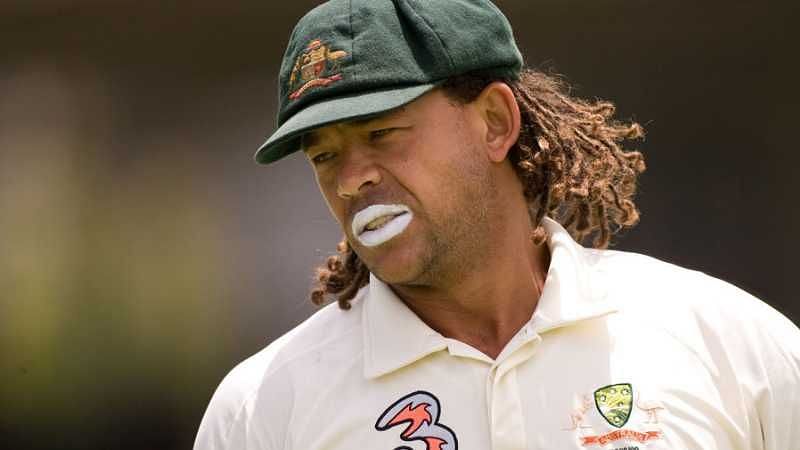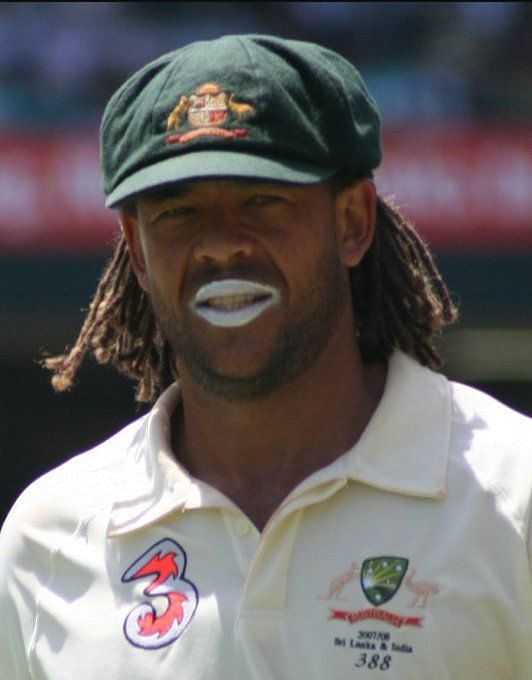
Andrew Symonds - A white-ball pioneer ahead of his time

11th February 2003, Johannesburg. Australia and Pakistan have gathered at Johannesburg to produce another rendition of their titanic rivalry. In 1999, the Aussies defeated Pakistan in the summit clash of the World Cup and denied the Men In Green their second title. So, from a Pakistan perspective, this was as novel a chance for payback as any.
As the crowd gradually starts building, the Australian players emerge for their pre-game routines. Matthew Hayden is his imposing self. Adam Gilchrist is leaving many gobsmacked by his sheer talent. Ricky Ponting is hitting the stumps at almost every time of asking. Brett Lee is bowling thunderbolts. And Glenn McGrath is landing the ball on a coin.
This Australian side is dripping with extraordinary quality. Wherever you look, there is a superstar. Among all of that, though, there is a burly figure also practicing with the side. A lot at the venue haven’t really heard of him. They look at his stature and assume that he is another towering Australian fast bowler.
But in contrast to how pacers were back then, he is gliding along the turf like a gazelle, fielding as well as anyone at the ground and almost hitting the stumps at will. Still, there is just too much star value elsewhere for the crowd to concentrate on this youngster, who only made his ODI debut in 1998.
The game begins. Pakistan, courtesy of their irresistible bowling line-up, win the toss and bowl first. Their decision is vindicated almost immediately. Wasim Akram gets the better of Gilchrist in the 3rd over. Hayden perishes to Akram a few overs later, and then, as a damning nail in the coffin, Ponting falls to the raw pace of Shoaib Akhtar. Damien Martyn, too, is cleaned up by Akram.
All of a sudden, the match, which was supposed to be a brazen portrayal of how far Australia had come since their previous World Cup triumph, is turning into a bit of a nightmare. It certainly wasn’t what they had expected, and it most definitely wasn’t something the crowd thought they would see.
So, there was plenty to panic about – even at this early juncture. For some reason, however, Australia looked very calm in their dressing room. Not because they had an embarrassment of riches in the bowling department. But because they knew they had a clutch player in their middle order.
This cricketer, by the way, had only tallied 762 runs across 38 innings at an average of 23.81 – well short of the standards those around him usually set. On past record alone, there wasn’t much for Australia to be excited about. Even at that stage, though, Australia knew what Andrew Symonds was all about. And by the time he was done at Johannesburg that day, almost the rest of the world knew too.
Symonds scored 143 runs off 125 balls that afternoon – in a manner that became synonymous with him thereafter. It wasn’t the most conventional knock anyone had ever witnessed in their lifetime. It was powerful. It was bruising. It was muscular. But most importantly, it was breath-taking. And it was just what Australia needed.
Throughout his career, Symonds developed a habit of standing up when Australia required him most. During the 2003 World Cup, he scored two more fifties – one against Namibia and one against Sri Lanka. The essay against the Islanders, in particular, was quite revealing. That innings wasn’t even eerily similar to what he had produced against Pakistan. This was a 91-run knock off 118 balls. It was just as crucial, though.
There have been many other standout moments in Symonds’ white-ball career. The hundred at Nagpur in MS Dhoni’s first series as India’s ODI captain. The swashbuckling 156 against New Zealand at Wellington. The breezy 151 against Sri Lanka at Sydney. And the dextrous 103* against Bangladesh at Fatullah.
Each was an illustration of Symonds’ buccaneering batting tendencies. But if the occasion demanded, he was also capable of buckling down, biding his time and doing just what his team required. In a side of superstars, he often flew under the radar. It is, to be fair to him, quite understandable, considering he shared the stage with Messrs. Gilchrist, Hayden and Ponting.
None, though, would be able to argue he wasn’t as talented as the aforementioned troika. He might not have had as celebrated a career as some of the other Australians during that era. But none of that success would have been possible if Symonds wasn’t acting as their guardian angel.
In Test cricket, too, he held his own. An average of 40.61 across 26 matches isn’t bad at all. This also included a heroic hundred in the 2006-07 Boxing Day Ashes Test alongside Hayden, despite walking into a perilous situation for Australia. There was another ton against India at Sydney, although that was marred by the controversy that followed.
Unfortunately, Symonds had quite a few run-ins with the authorities, opposing players and even his own teammates. For a stretch of his career, it even threatened to become his lasting legacy. To an extent, anyone who watched his career unfold towards the late 2000s, would testify that that is the case.
Andrew Symonds was a white-ball pioneer
But those who either witnessed Symonds in the flesh, or watched him tear bowling units apart – even during an era when that wasn’t quite the vogue, would argue otherwsie. He finished his ODI career with a strike rate in excess of 90 and when he turned up for the IPL, he captured the imagination with the now-defunct Deccan Chargers. In Test cricket, his strike rate of 64.8 was way ahead of his time as well.
So, it is actually quite tough to understand what larger category Symonds’ career falls under. Was it a classic case of a player not fulfilling his potential, or a tale of a cricketer throwing away everything because of a few injudicious choices? The true answer, though, lies somewhere in between.
Symonds never compromised on how he played cricket and was as passionate as anyone to have ever represented Australia, irrespective of whatever anyone might say. If it came to that, he would even go to war for his country and for his teammates. The extreme commitment and obsession to be there for those around him might have rubbed off on some people the wrong way.
But at a time when ODI cericket was still relatively slow-paced (as compared to its modern contemporary), he was a pioneer – a middle-order bruiser who grabbed games by the scruff of their necks and tilted them his side’s way. He was a match-winner in the field too. And he was a lovely bloke off it.
Over the years, not many have been able to accomplish that. And even if they have, it has only happened after Symonds had told them it was achievable. In a team consisting of Gilchrist, Hayden and Ponting, it is quite revealing that he has left a lasting cricketing legacy.
Even back in 2003, Australia knew what he was capable of. When almost all of their much-vaunted batting unit fell, they felt secure that Symonds was around. Some unforeseen events have meant that the all-rounder won’t be around to see how the game he loved keeps evolving. But whenever talking about belligerent white-ball middle-order batters in the 21st century, his name will be at the forefront.
Ahead of all the controversies. Ahead of all the conversation about him not fulfilling his potential. And most tellingly, ahead of many who played the game before and after him.
Rest in peace, mate!
